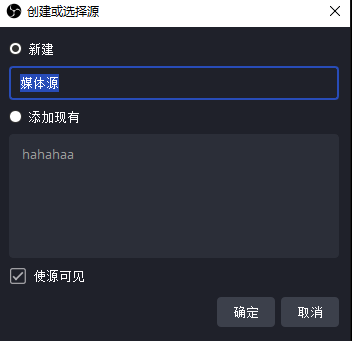OBS用户添加源实例
2024-03-22
110
0
上一节知道,在OBS中任右键,会弹出一菜单,可以添加通过插件模块注册的各种”输入源“
当在菜单中选中某种类型的”输入源“之后,就会调用函数AddSource。其中 id是各个模块注册输入源时提供的源id,该ID应全局惟一。
void OBSBasic::AddSource(const char *id)
{
if (id && *id)
{
//创建QT对话框对象。OBSBasicSourceSelect继承于QDialog
OBSBasicSourceSelect sourceSelect(this, id, undo_s);
//弹出并显示对话框,等待用户输入信息
sourceSelect.exec();
//参数校验
if (should_show_properties(sourceSelect.newSource, id))
{
//创建输入源实例
CreatePropertiesWindow(sourceSelect.newSource);
}
}
}
AddSource函数分两步:
对话框OBSBasicSourceSelect
第一步是通过使用OBSBasicSourceSelect弹出结话框。OBSBasicSourceSelect继承于QDialog,故通过exec()函数显示对话框。
用户配置弹出对话框做相应的配置选择后。点击确认后,执行的是函数OBSBasicSourceSelect的成员函数on_buttonBox_accepted。
该函数会根据是新建还是添加现在执行不同的流程:
void OBSBasicSourceSelect::on_buttonBox_accepted()
{
bool useExisting = ui->selectExisting->isChecked();//新建按钮是否选中
bool visible = ui->sourceVisible->isChecked();//便源可见选项
if (useExisting){
...
}
else //添加新源
{
//名称是否为空,默认名为媒体源
if (ui->sourceName->text().isEmpty()) {
OBSMessageBox::warning(this,
QTStr("NoNameEntered.Title"),//请输入一个有效的名称
QTStr("NoNameEntered.Text"));//您不能使用空白名称。
return;
}
//添加新源
if (!AddNew(this, id, QT_TO_UTF8(ui->sourceName->text()), visible, newSource))
return;
...
}
done(DialogCode::Accepted);
}
AddNew函数的原理校验用户输入的名称重复性,如果不重复,就创建源实例,创建后的新源实例加入场景中。
bool AddNew(QWidget *parent, const char *id, const char *name,
const bool visible, OBSSource &newSource)
{
//获取主窗口
OBSBasic *main = reinterpret_cast<OBSBasic *>(App()->GetMainWindow());
//获取主窗口当前的场景
OBSScene scene = main->GetCurrentScene();
bool success = false;
if (!scene)
return false;
//是否名字已经存在
OBSSourceAutoRelease source = obs_get_source_by_name(name);
if (source && parent) {
OBSMessageBox::information(parent, QTStr("NameExists.Title"),
QTStr("NameExists.Text"));
}
else
{
const char *v_id = obs_get_latest_input_type_id(id);
source = obs_source_create(v_id, name, NULL, nullptr);
if (source)
{
AddSourceData data;
data.source = source;
data.visible = visible;
//添加到当彰场景中
obs_enter_graphics();
obs_scene_atomic_update(scene, AddSource, &data);
obs_leave_graphics();
...
}
}
return success;
}
创建源属性对话框
使用AddNew添加新源,而newSource以引用的方式返回,即sourceSelect.newSource
if (should_show_properties(sourceSelect.newSource, id)) {
CreatePropertiesWindow(sourceSelect.newSource);
}
新创建的源是struct obs_source_t类型,新创建的源需要进行配置。所以这里会通过CreatePropertiesWindow函数创建并显示属性对话框。
void OBSBasic::CreatePropertiesWindow(obs_source_t *source)
{
bool closed = true;
if (properties)
closed = properties->close();
if (!closed)
return;
properties = new OBSBasicProperties(this, source);
properties->Init();
properties->setAttribute(Qt::WA_DeleteOnClose, true);
}
如对于视频媒体源加的属性对话框:
 OBS源
OBS源





